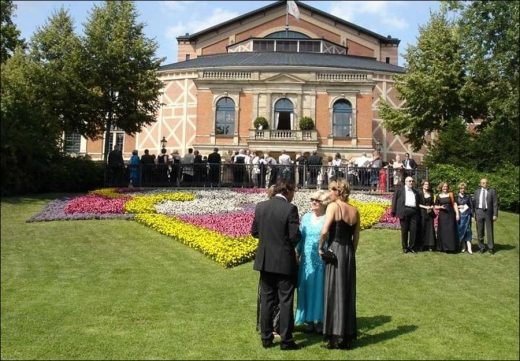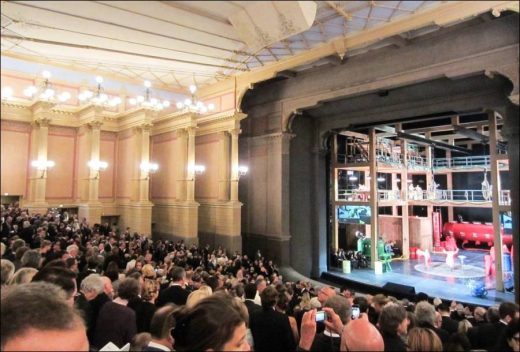As the clocks show 16:00 (4:00 p.m), with the last warning bell ringing, the doors lined up on both sides of the hall are locked with the key from the inside by the attendants. The auditorium, which had been humming until that moment, falls into deep silence as the ornate glass bells placed on top of the Corinthian capped columns protruding from the side walls and directing all eyes to the stage begin to darken.
When the lanterns are completely lifeless and you can’t tell the person sitting next to you from the darkness, your eyes wandering around are caught by a weak light beam filtering out from the opening in the front of the stage. An intense music that you realize started coming from there not long after 10 seconds, is gradually covering the entire auditorium. Welcome to the Bayreuth Festival!
The Bavarian town of Bayreuth, with its Festival and its main venue, means a lot to the fans of the German composer Richard Wagner, who lived between 1813 and 1883. Wagner’s unique musical dramas had the most ideal stage in the world when this theater building, known as “Festspielhaus” for short, was among the sponsors of the Ottoman Sultan Abdulaziz of the period, when it opened in 1876. You may not believe it, but Festspielhaus still offers the most ideal staging conditions for Wagner’s complex works, each of which takes 3-4 hours, after all these years.
I wanted to visit the Bayreuth Festival, which every Wagner enthusiast would like to visit once in their life, between 13-19 August with my title, which was registered by the Festival as “the first writer accredited by the Turkish press in its 136-year history”, and to reveal a little bit of the secret behind this miracle.
During my one-week visit to Bayreuth with Andante writer Feyzi Erçin, beyond seeing that all my previous knowledge about Bayreuth, which was already in my vocabulary, was confirmed, the unique location of this festival was further consolidated in my mind with my on-site observations.
It is not in vain to use the term “pilgrimage” for festival goers and “Bayreuth pilgrimage (pilgrimage)” for the journey to the Festival. Imagine an audience of 2000 people who flock from all corners of the world in August each year to watch all the Wagner operas being staged that year in a week’s time in unventilated, extremely uncomfortable seats for hours each evening with great discipline and awe. What would you call “Bayreuth pilgrims” for those people who wander around in the one-hour gaps between the curtains – as if they are circumambulating the Festspielhaus – and when the performance that evening ends at around 10:15 pm, they disperse to the restaurants of the city and engage in lively conversations about the operas they watch and Wagner?
This year’s Bayreuth Festival, which will last until 28 August, is already full of excitement for next year, because in 2013 the 200th anniversary of Wagner’s birth will be celebrated. With Frank Castorf’s new Ring of Nibelungen directorship, the Bayreuth Festival will salute this great man to whom he owes his birth!
Festspielhaus, which was built on a green hill overlooking Bayreuth, draws attention with its completely wooden structure. The excellent acoustics of the 2000-seat auditorium are legendary. Columns that expand inward as they approach the stage from both sides and the “hidden orchestra pit” play a significant role in the superiority of acoustics. This orchestra pit, invented by Wagner, is unique to the Festspielhaus in the world. Wagner, who wanted the audience to focus all their attention on the stage and that the auditorium was not exposed to any light, found the solution to hide the orchestra from almost “everyone”
Not only the audience, but also the singers on the stage cannot see the members of the orchestra, who descended six steps to the bottom of the stage! In this case, the biggest task falls to the conductor, who has to ensure the coordination between the orchestra and the stage. If you ask who is having the most trouble at Festspielhaus, everyone will answer as the conductor. Being a very good conductor is not enough to dominate the grueling orchestra pit of Bayreuth, if that conductor wants to receive an invitation next year, he must know the intricacies of the hall acoustics and be able to trust his intuition.
There was no new production this year at the Bayreuth Festival, where Wagner’s mature operas are staged every year. In the 6 days I spent in “Green Hill”, as its regulars call it, I had the opportunity to watch 5 Wagner productions that were notable for the previous years. Productions of Lohengrin, Tannhauser, Tristan and Isolde, Parsifal and The Flying Dutchman competed with each other to be extraordinary, innovative and provocative.
In a week, I had the opportunity to watch the most aesthetic examples of the “regietheater” (director’s theater) movement of Germany, which raises dozens of questions in one’s mind even when it comes to well-known works. In the hands of creative directors, who know the music very well (which is a very important factor in opera), this movement, which is tried to be destroyed as “Eurotrash” (European garbage) in geographies outside Europe, will be able to save the bloody and repetitive opera art from the spiral it has fallen into. I realized it was a life preserver.
What did the 136-year-old Festspielhaus not see this year? Transported to a sterile laboratory at the hands of Hans Neuenfels, the Brabant people of the opera Lohengrin were turned into guinea pigs. Sebastian Baumgarten, who signed one of the most controversial directors of the festival, placed a huge alcohol production facility in the heart of Wartburg, which he turned into a place for alcohol production in Tannhauser’s opera.
In the stage where Elisabeth ended her life in a biogas container, Venus became pregnant with Tannhauser, and Wolfram von Eschenbach was dancing his famous aria in the last act, dancing in Venus’s arms! Jan Philipp Gloger’s critique of “brutal capitalism” in his opera The Flying Dutchman, through his fictionalized sailors as white-collar salesmen of a fan workshop, was simply brilliant.
We witnessed an incredible light and decor show, and Stefan Herheim’s Parsifal director chose to tell the “holy grail” story by taking the 100-year period from Germany’s unification at the end of the 19th century to the establishment of the Federal Germany in its background. Contrary to the directors who chose to tell many things on the same stage due to the multi-layered interior structure of Wagner’s gigantic works, Christoph Marthaler was content to carry the love of Tristan and Isolde to the 1960s, signed a static directorial and very simple decors based on the metaphor of the ship’s sinking gradually. had thrown.
I am aware, I have listed some directorial details that made me say “no more” while I was writing it. But imagine that these and many more were brought to life in one of the world’s largest opera stages, accompanied by a magnificent orchestra, by today’s most advanced technical equipment, especially the light, and by today’s most masterful Wagner singers. If you’re a conservative Wagnerian, you might boo as some do when the final curtain comes down, of course, but if you’re among those who make up the overwhelming majority of the auditorium, you’re likely to join the roaring bravos after these performances.
Speaking of singers; From Klaus Florian Vogt to Irene Theorin, from Kwangchoul Youn to Samuel Youn, from Camilla Nylund to Adrianne Pieczonka, Bayreuth has become the official parade of the world’s most glorious singers. On an interesting note, all A-class singers said yes to Bayreuth – for Wagner’s sake – to much lower stamps than they got on other big stages.
Let’s say you wanted to go to Bayreuth next year to watch the festival after reading these lines. Not to upset your morale, but your ticket request is unlikely to be accepted in your first application. The reason is actually very simple. The number of requests for tickets to the month-long festival exceeds the total number of seats at Festspielhaus. For example, last year, 360,000 ticket applications were made against a total of 60,000 seats. Here we come to the stereotype “Wait 8-10 years to get tickets to the Bayreuth Festival”.
This year, when I encountered an Englishman who had waited 12 years for a Bayreuth ticket, I stopped questioning the validity of this wait, which I thought was exaggerated. Moreover, it is not enough to apply once. In order not to be thrown at the end of the waiting line, you must persistently submit your request to the Festival office every year.
In order to shorten the waiting period, you must either get to know one of the corporate sponsors, become a member of the Festival’s friendship association with more than 5000 members, or join one of the national Wagner societies, which number around 200 in the world. In the meantime, let’s give the good news that this closed ticket policy of the Festival, which has been criticized in recent years, is being improved for the benefit of large masses of people as of this year.
After the death of Richard Wagner in 1883, the Bayreuth Festival was managed by his wife Cosima Wagner, his son Siegfried Wagner and his bride Winifried Wagner, respectively. After the early death of Wieland, Wolfgang Wagner, who took over the management alone for years, retired in 2008, and the fight for the throne, which was not comparable to Wagner operas throughout the 2000s, comes to an end in Bayreuth and Wolfgang’s daughters Eva and Katharina will end in 2015. They are appointed as festival director.
The close stance of the Bayreuth Festival to the Nazis constitutes the most controversial pages in the history of the Festival. Adolf Hitler never spared his interest in his favorite composer, Richard Wagner and his Festival, and visited the ‘green hill’ many times. The correspondence of Winifried Wagner, the ‘iron lady’ of Bayreuth, whose contracts of Jewish musicians were terminated during the Second World War, with Hitler has still not been shared with the public by the Wagner family.
The shadow of the Nazis did not leave the Bayreuth Festival alone this year. The famous Russian baritone Yevgeni Nikitin, who was engaged for the role of the Flying Dutchman, was dismissed from the cast just days before the start of the Festival by the new Bayreuth administration, which aims to erase the traces of the Nazis from his past, after the swastika tattoo he had in his youth was revealed in a photograph reflected in the press.
Views: 485




